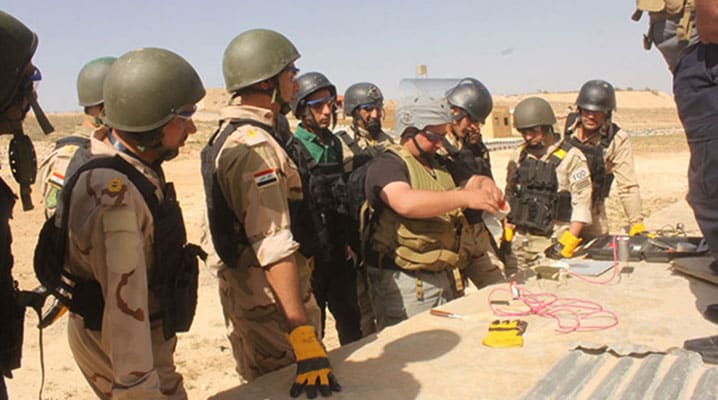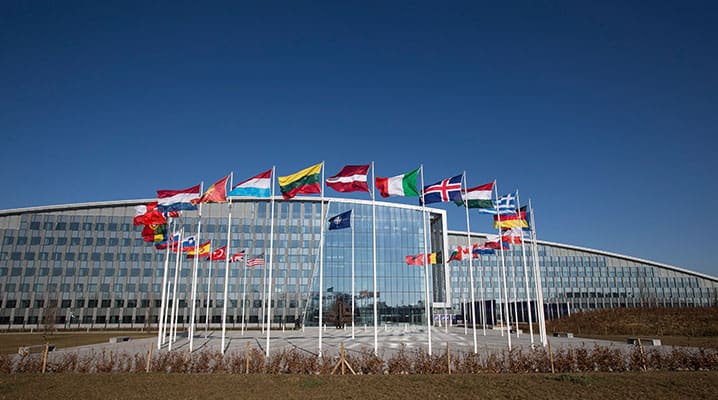And somewhere from the dim ages of history the truth dawned upon Europe that the morrow would obliterate the plans of today.
As NATO approaches yet another Summit, a flurry of academic and non-governmental expert advice and opinion is once again flooding the media space on how to adapt NATO in an unpredictable and fast-changing world. This is a very welcome, important and necessary public debate.
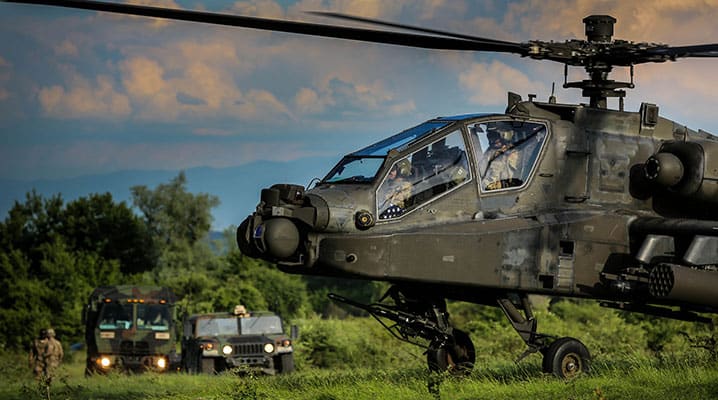
A US AH-64 Apache attack helicopter touches down at a training area near Cincu, Romania to test the Very High Readiness Joint Task Force, during the NATO Noble Jump military exercise – June 2017 © NATO
What the expert community often overlooks, however, is the unique nature of NATO’s business (matters of war and peace) and the unique nature of its mandate (collective defence of the territory of 29 Allies and their population of one billion). This is why some NATO policies, decisions and actions cannot be made public at this time. This inevitably leads to some guesswork, informed or otherwise.
And that is the point: those “to whom it may concern” must have absolute certainty in the resolve and ability of NATO to respond to any attack or aggression, as stipulated in the Washington Treaty – but NATO will remain deliberately ambiguous as to the precise nature, scale, timing, domain(s) and target(s) of its response. NATO’s official silence on some of the ubiquitous expert advice on where and how NATO should improve, does not mean the Alliance has not done it already or is not in the process of doing it.
The aim of this article is to provide a broad overview of the Alliance’s overall posture, as it has been implemented since the Warsaw Summit, and the potential next steps in the Alliance’s ongoing adaptation. In doing so, the article will also address some of the lingering – or new – misperceptions about what the Alliance can or cannot do in defence of its territory and population.
Citius, altius, fortius
The Cold War posture was geared towards deterring, and, if necessary, withstanding an imminent Soviet conventional and nuclear onslaught. It was all about mass: massive forces; massive amounts of firepower and nuclear weapons; and a mutually assured guarantee of mass destruction, if deterrence failed. An immediate response was inevitable, as it was inherent to the posture itself.
It has taken the Alliance nearly 20 years to transform itself into an expeditionary culture, centred on smaller, lighter, more mobile units able to deploy far outside NATO’s borders for peacekeeping, countering insurgency, providing humanitarian relief or supporting stabilisation and reconstruction.
The post-Cold War era was all about mobility, flexibility and agility – light, multi-task forces able to fight off terrorists, train local forces, and build schools and hospitals at the same time. At one point, NATO was able to deploy, sustain and command over 130,000 troops from some 50 Allies and partner countries in Afghanistan. No other multinational organisation has ever even attempted such a feat – nor would be able to.
The post-2014 era is about both mass and speed: bringing back heavier forces and larger formations without losing speed and mobility. Moreover, speed is even more of the essence. During the post-Cold War era, NATO conducted mostly discretionary operations: Allies engaged when and where they wanted to engage. Today, NATO is facing a non-discretionary environment, in which its potential adversaries choose the time and place for their ‘strategic surprises’ without giving Allies much notice, and terrorist attacks often have no warning at all.
The current environment is different from the Cold War days in one fundamental way: the Cold War opponents were status-quo powers, invested in maintaining strategic stability. Today’s potential adversaries are deliberately seeking to undermine and ultimately destroy the Euro-Atlantic security architecture.
Since the historic decisions taken at the NATO Summits in Wales (in particular on the Readiness Action Plan and the Defence Investment Pledge) and Warsaw (in particular on the Alliance’s Strengthened Deterrence and Defence Posture and Projecting Stability), NATO has been getting stronger, faster and, with the accession of Montenegro in 2017, larger.
NATO has tripled the size of the NATO Response Force, from 13,000 to about 40,000 troops, including by adding a ‘spearhead force’ (the Very High Readiness Joint Task Force) which can be deployed on very short notice wherever needed.
NATO has enhanced its training and exercise regime, to cover all directions and all contingencies, and reviewed its defence plans and developed new ones.
NATO has been addressing the complex challenges emanating from and beyond the Middle East and North Africa, in particular by assisting its broad network of partners and supporting the Global Coalition to Defeat ISIS/Daesh.
NATO has deployed four multinational enhanced Forward Presence (eFP) battlegroups on the territories of Estonia, Latvia, Lithuania and Poland, and established a tailored Forward Presence in the Black Sea region.
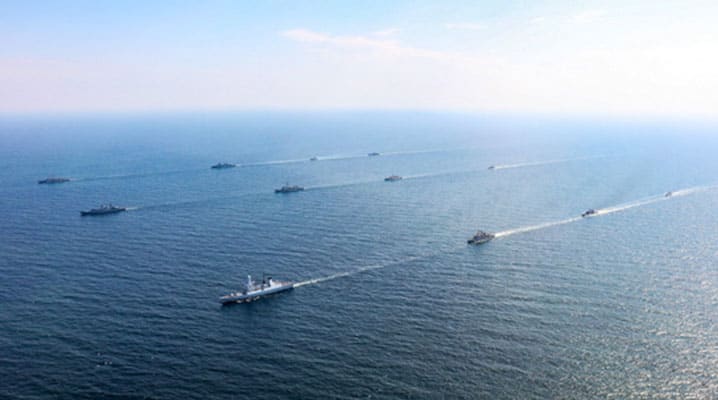
As part of the Alliance’s strengthened deterrence posture, NATO maritime forces have increased their presence in the Black Sea and conduct regular exercises to improve their communication and interoperability skills. © NATO MARCOM
NATO is adapting and strengthening its command and control capability, including by establishing a new joint force command focused on the Atlantic and a new joint support and enablement command to facilitate movement of forces.
No less importantly, Allies have committed to delivering heavier and more high-end forces and capabilities, as well as more forces at high readiness.
And the list can go on. This is not to say that NATO has reached the end of its adaptation. The current cycle of Alliance adaptation started just four years ago. A good deal of progress has already been achieved but it will take more time to re-centre the mind-set on the collective defence of Alliance territory and populations.
Dispelling myths
As NATO presses ahead with its adaptation agenda, it is important to dispel some lingering, widely-held myths.
Myth 1: Alliance cohesion is frail.
Allies do disagree. There are different views about Russia; about partners; about the South. There are worries about the health of democracy in different parts of the Alliance. There are questions about the strength of commitment of 29 Allies to Article 5 (the collective defence clause) of the Washington Treaty. And that is understandable.
NATO has weathered crises in the past. There was the Suez crisis, there was France’s withdrawal from NATO’s military structure; there were military regimes coming to power in some Allied countries; and there was the Iraq crisis of 2003. NATO has survived and grown bigger. And no Ally has ever opted to exit.
Yes, NATO is an intergovernmental organisation. It takes all decisions by consensus. And Allies can disagree on everything. But the culture of thorough debates and consultations is what makes the Alliance so strong. And it can speak softly and tread lightly with potential adversaries, because it carries a very big stick.
Despite crises, disagreements and the very deliberate attempts by some potential adversaries to undermine Alliance unity and cohesion, since 2014 the resolve and solidarity of Allies has strengthened. Mutual understanding of each other’s security concerns has improved. Northern and eastern Allies have a much better understanding of the predicament of the southern Allies, and southern Allies appreciate the potential threats faced by the eastern Allies.
A better shared understanding of a more demanding security environment contributes to improved burden-sharing across the Alliance. Defence spending across NATO is estimated to grow for the fourth consecutive year in 2018. The Alliance is strengthening its deterrence and defence at its borders; enhancing its projecting stability efforts beyond its borders, in particular by providing defence capacity building support to its partners, and enhancing its contribution to the international fight against terrorism. And NATO has just moved to a new state-of-the-art headquarters.
Bottom line: NATO is most definitely not an organisation in decline and NATO’s unity is intact.
Myth 2: ‘The Baltics will fall in 48 hours.’
While the ‘survival’ time estimates by different analysts vary, it is almost universally assumed in the West that the Baltic capitals would fall very quickly, if attacked by Russia. This myth was around before Estonia, Lithuania and Latvia became members of NATO in 2004. It was even used as an argument against their membership. Because they are so indefensible, the argument went, their membership would weaken rather than strengthen NATO’s security.
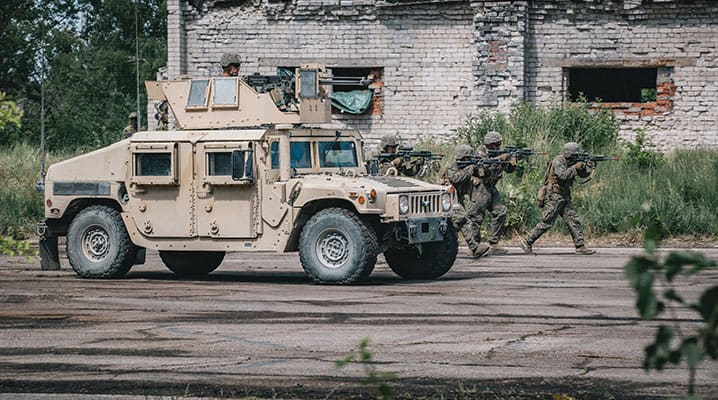
Latvian soldiers train together with soldiers from the Canadian-led enhanced Forward Presence battlegroup, the US 2nd Cavalry regiment and US Army cadets in a simulated urban warfare scenario, during the NATO Saber Strike exercise – June 2018.
(Photo by SSG Gatis Indrevics, Latvian Combat Camera Team)
A recent RAND study has argued that at least seven heavy armoured brigades supplied by Allies would be necessary to slow down a Russian attack. Such assessments barely take into account, if at all, the indigenous forces of the three Baltic Allies and generally ignore the actual history and resilience of the Baltic nations.
It took the Red Army ten years after the end of the Second World War to finally suppress the armed resistance in Estonia, Latvia and Lithuania, at a significant cost also to the Soviets. Civil resistance continued throughout the Soviet occupation, contributing to the fall of the Soviet Union.
Yes, they can be attacked – but Estonians, Latvians and Lithuanians will ferociously defend every square metre of their territory. And this time they will not be alone. NATO is really lucky to have such resilient nations protecting its eastern flank.
Bottom line: the Baltics are not indefensible – they are not subjugable.
Myths 3 & 4: NATO’s posture is insufficient to deter; NATO’s posture could lead to inadvertent escalation.
There are generally two schools of thought on NATO’s posture: some believe that the efforts to strengthen the Alliance’s posture are by and large insufficient to deter Russia. Others believe that the Alliance’s increased activity on its flanks may lead to military incidents and escalation. Both arguments are mistaken.
The Alliance’s posture agreed at the Warsaw Summit is fully sufficient to deter a near-peer adversary. The modest but persistent combat presence of Allied forces from some 20 Allies, including the three nuclear powers, on the territories of Estonia, Latvia, Lithuania and Poland, as well as the exercise presence of Allied forces in the Black Sea region, is a strong deterrent tailored to the potential threat in these two regions. As part of NATO’s overall posture, the purpose is to unambiguously demonstrate the Allies' solidarity, determination and ability to act, by triggering an immediate response to any aggression by the Alliance as a whole.
The ‘unintended escalation’ school of thought distorts the perception of the Alliance’s activities by introducing moral equivalence between Russian actions and NATO’s efforts. NATO did not illegally annex Crimea; NATO did not attack eastern Ukraine; NATO does not perpetrate information wars or cyber-attacks on any country.
The Alliance’s posture is strictly defensive. There is no risk that the Alliance can miscalculate anything, because it has no aggressive designs on any country. The Alliance’s actions simply cannot be escalatory. On the contrary, the Alliance’s strengthened posture and clear messaging reduce the potential for misunderstanding or miscalculation – deliberate or not – by any potential adversary and, therefore, reduce the risk of escalation. As Allied leaders stated at the Warsaw Summit, ‘no one should doubt NATO’s resolve if the security of any of its members were to be threatened.’
Bottom-line: the Alliance’s posture is effective, defensive and de-escalatory by nature.
Myth 5: There is unnecessary duplication between NATO and the European Union.
Much effort has been spent on discussing, analysing, promoting and criticising the relationship between NATO and the European Union (EU).
There have been American concerns, as in the famous ‘three Ds’ of Madeline Albright – no decoupling (of transatlantic security), no duplication (of NATO’s structures) and no discrimination (towards non-EU Allies).
There have been some expressions of aspirations for the EU’s ‘strategic autonomy’ and a defence role independent from NATO and the United States.
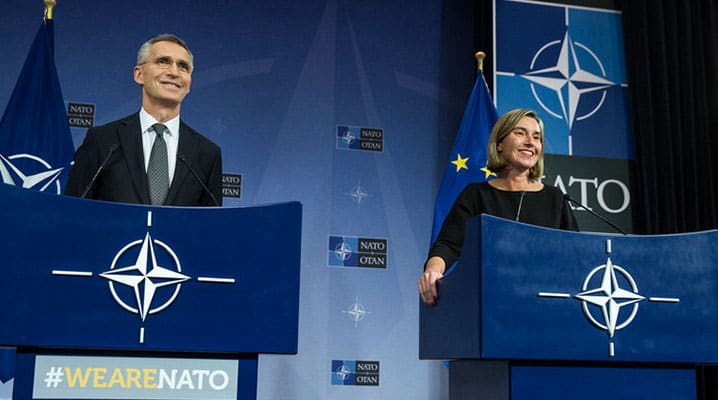
Since 2016, NATO and the European Union have been strengthening cooperation to address shared security challenges in their eastern and southern neighbourhoods. © NATO
There has been exasperation by the Alliance’s leaders, as in former NATO Secretary General Jaap de Hoop Scheffer having to deny that there is a ‘frozen conflict’ between the two organisations. There were even offers to ‘forget’ NATO-EU cooperation, on the grounds that it is a ‘Potemkin village’.
None of these exaggerations holds true. The jolts of 2014 – aggression against Ukraine, rise of Daesh and mass migration – were equally felt by both NATO and the EU. These challenges have prompted an unprecedented level and breadth of cooperation between the two organisations, notwithstanding the well-known political difficulties.
There is no real risk of duplication, nor of poor division of labour, because the two organisations are in different ‘labour markets’ and have different but complementary mandates. The EU’s defence project is all about European Defence (i.e. primarily strengthening the capabilities of EU member states for crisis-response operations outside the EU). NATO is all about Defence of Europe (i.e. primarily strengthening the capabilities of Allies to ensure the collective defence of Allied territory and population).
And this is not going to change. NATO Secretary General Jens Stoltenberg has stated on numerous occasions that a stronger European Defence is good for Europe and therefore good for NATO: first, at least currently, 22 Allies are also members of the EU; second, it has the potential to provide new and better capabilities, and to improve burden-sharing within the Alliance.
Both organisations provide specific contributions to making the Euro-Atlantic region more secure. They cooperate closely, when and where appropriate, on more than 70 measures in total, including new areas, such as military mobility.
Bottom line: both NATO and the EU are indispensable for Euro-Atlantic security and defence.
Addressing the real challenges
Notwithstanding these apocryphal difficulties, NATO does need to deal with a number of challenges, and the Brussels Summit in July 2018 provides a good opportunity to do so.
First, a clear perception of Russia
There is a strong consensus among Allies to continue the so-called dual track approach towards Russia: pursuing a meaningful dialogue on the basis of a strong deterrence and defence posture. This policy will hold at, and beyond, the Brussels Summit.
At the same time, the views among Allies continue to differ as to whom they are talking to: a former partner, who will hopefully become a partner again someday; a near-peer competitor; a potential adversary; or even an enemy already in conflict with the Alliance. Elements of all these views of Russia can be found in Allied leaders’ declarations at both the Wales and Warsaw summits.
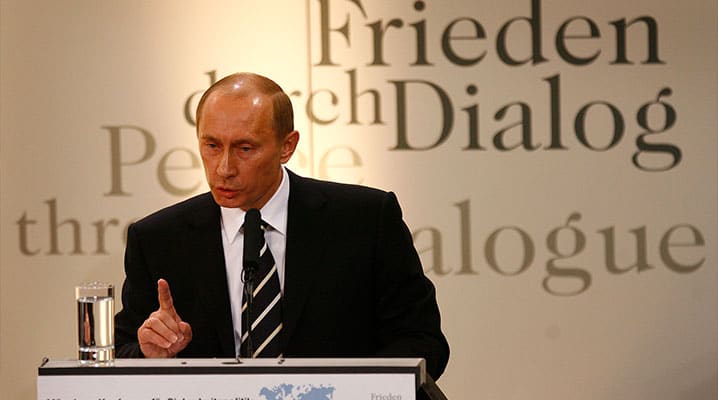
A sign of things to come: Russian President Vladimir Putin assertively challenges the post-Cold War international order in a bellicose speech at the 43rd Conference on Security Policy in Munich – 10 February 2007. © Reuters
One could argue that the Cold War remained cold mostly because of a deliberate effort by both sides to build and uphold strategic stability through nuclear parity, strategic arms control and a clear-eyed view of the other side’s ideology, intent and capabilities.
Arguably, the Russian leadership does have such a clear-eyed view of NATO, in the form of Russia’s perceived ‘encirclement’; the ‘coloured revolutions’ in Russia’s ‘near abroad’; the perceived threat of NATO’s ‘expansionism’ and ‘warmongering’. Effectively, Russia believes it is already in a low-end conflict with the West.
This creates a perception gap between how Russia sees the West (in conflict with a hostile US-led alliance) and how NATO sees Russia (neither in peacetime nor crisis; neither enemy nor partner). This perception gap is dangerous because it can lead to inadvertent misunderstanding and miscalculation, especially if Russia mistakes the intra-Alliance deliberations as a sign of division or weakness.
NATO is neither divided, nor weak, but it clearly needs a coherent Russia policy, not just the dual-track approach, as sound as it is. This is a key pre-cursor for re-establishing a truly meaningful dialogue with Russia as it is, not with Russia as Allies would like it to be.
Second, a ‘game changer’ for the South
NATO is constantly facing a ‘damned if you do, damned if you don’t’ dilemma when it comes to the Middle East and North Africa (the South). For example, NATO has been blamed for intervening in Libya, which led to the fall of Gadhafi. Yet, it was also blamed for leaving Libya after the active campaign, which was followed by state failure and civil conflict. Similarly, Allies have been criticised for not intervening early on in Syria to stop Assad’s atrocities against his own people, which also led to civil war, and the rise of ISIS/Daesh.
NATO has decades of experience dealing with state actors like Russia. It is much more challenging for NATO to fully understand, analyse, assess and relate to the multifaceted developments in the Middle East and North Africa – especially after the Arab Spring, when the stagnant but stable secular autocratic regimes started to crumble.
NATO has already taken steps towards gaining better understanding and enhanced situational awareness of the region, including through the implementation of the Framework for the South and the establishment of the Regional Hub for the South within the Joint Force Command Naples. However, the challenge is further exacerbated by the fact that the toolkit of a defence organisation is not fully fit for the magnitude and complexity of the challenges emanating from the South.
NATO has never had to deal with such a complex and multifaceted set of security problems. While, in some cases, these challenges reverberate far beyond its territory, they also have a direct impact on the Allies’ population and way of life, for instance, by posing a present and immediate danger of terrorist attacks anywhere on NATO territory.
For example, NATO is providing some assistance in the Aegean to address the refugee crisis but it has no mandate or capacity to directly address the root causes of migration. NATO also supports the Coalition to Defeat ISIS/Daesh, and provides some counter-terrorism training to partners in the region and advice to Allies – yet it has no mandate or capacity to address, counter or respond to the terrorist attacks that have been occurring in multiple cities across NATO. And NATO has a partnership network across the Middle East and North Africa in the form of the Mediterranean Dialogue (seven partners) and the Istanbul Cooperation Initiative (four partners). NATO is substantially engaged in providing assistance or advice to all these partners.
However, notwithstanding all these efforts, taken together, they do not appear to have made a significant difference in preventing the deterioration of the security situation across the region.
NATO currently pursues a discretionary approach – NATO engages only when and where the Allies choose to engage, when called upon by the United Nations and/or invited by a host nation. As a result, NATO’s ‘operational’ profile and military footprint in the Middle East and North Africa has so far been very limited. NATO’s ability to run complex, multinational, long-lasting crisis management operations – as exemplified by the International Security Assistance Force in Afghanistan (2003-2014) – is arguably the most effective and consequential tool in the Alliance’s toolbox, but it has not been used in the South.
There appears to be a need for a shift in the Alliance’s strategic thinking about and approach to the South. Projecting stability to the South is about Alliance security, which makes it an imperative and not an optional undertaking for NATO.
For NATO to have a truly strategic, stabilising effect on the South, the Alliance needs a ‘game changer’ to galvanise its role and efforts. One such ‘game changer’ could be a fully-fledged training and capacity building mission in Iraq, and/or a comprehensive engagement in Libya, ideally under the mandate of the United Nations and in close cooperation with the European Union.
Third, deterring and countering threats under the Article 5 threshold
Only one measure can determine how credible and effective deterrence is – the absence of attack or aggression. NATO’s deterrence and defence posture works well in deterring a major military attack on the Alliance. The threshold to trigger Article 5 has been passed only once in Alliance’s history – on 9/11.
On the other hand, NATO’s deterrence posture does not work in the case of numerous terrorist, hybrid, cyber, information and other non-military and non-conventional attacks that are occurring against NATO or individual Allies on a regular, if not daily basis.
In theory, NATO’s posture is supposed to address ‘any threat from wherever it arises’. In practice, however, Allies often choose other national or multinational avenues than NATO to address threats or attacks that do not amount to large-scale aggression.
For example, after the terrorist attacks in Paris, France invoked the solidarity clause of the EU Treaty and treated the attacks as a law enforcement, not a military/defence issue. And no Ally has brought issues associated with foreign interference in their national elections to the North Atlantic Council.
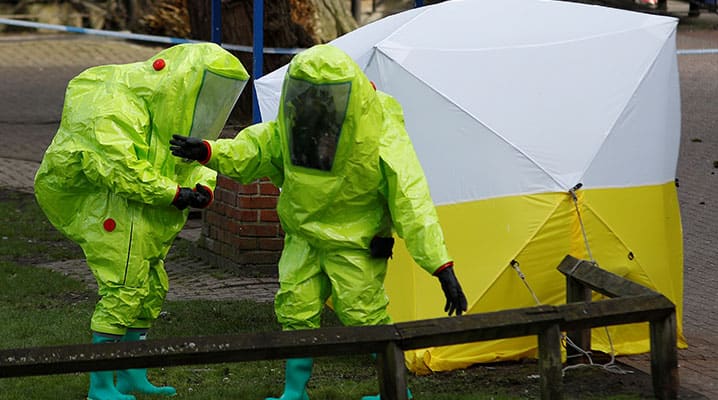
The attack on ex-spy Skripal and his daughter in Salisbury, the United Kingdom, on 4 March 2018, was the first offensive use of a nerve agent on Alliance territory since NATO’s foundation. NATO Allies were united in expressing deep concern about this clear breach of international norms and agreements. In the wake of the attack, Russian diplomats were expelled from the Russian Mission to NATO and from embassies across most
Allied countries. © Reuters
When it comes to cyber-attacks, attribution continues to be difficult, which also complicates the deterrence game.
This not to say that NATO is ignoring such threats, which are often lumped together under the heading ‘hybrid’. NATO is implementing a strategy on its role in countering hybrid warfare; the work on strengthening NATO cyber defence is progressing. NATO is also working with Allies on strengthening resilience and civil preparedness. And NATO is cooperating with the EU on all these issues. Perhaps most significantly, NATO has shown strong unity in the face of the Salisbury nerve agent attack.
However, while NATO is arguably getting better at recognition and attribution of such attacks, deterring or effectively countering such attacks continues to be difficult. Because in many cases they cannot be deterred by denial, nor by a credible threat of punishment (e.g. Allies would never consider unleashing a nerve agent attack in Russia in retaliation for Salisbury). Clearly, further strategic reflection and potentially a new policy paradigm is needed to deal with this ‘grey zone’ between peace and conflict.
Towards a theory of everything
At and beyond the Brussels Summit, Allies will be working towards a ‘theory of everything’ of sorts. Allies made multiple and far-reaching decisions at their summit meetings in Wales and Warsaw. Most of them have been or are being implemented. Now, Allies will need to consider how it all fits together, under the buzzword of ‘overall coherence’.
This work will be about achieving full certainty that the Alliance can credibly deter any aggressor and any threat from wherever it arises. This will require addressing any residual gaps and vulnerabilities in the Alliance’s posture that NATO’s potential adversaries may feel tempted to exploit.
Allies will consider ways to further improve NATO’s ability to take decisions at the ‘speed of relevance’ so as to be able to ‘fight tonight’. Allies also need to be able to ‘fight tomorrow’. To this end, the Alliance will further enhance its ability to rapidly reinforce any threatened Ally, wherever needed. This means having the right forces and capabilities, at sufficiently high readiness, properly positioned, equipped, organised, trained and exercised. This also means being able to move these forces from North America and across Europe. In this regard, NATO’s close cooperation with the European Union on military mobility is of key importance.
The Alliance will adapt and strengthen its military command structure.
The Alliance will keep its defence plans up to date, so as to be able to address any contingency, be it Article 5 or non-Article 5.
The Alliance will ensure that it is able to act decisively across operational domains: land, air, maritime, and cyber. And NATO will develop a Space Policy.
The Alliance will continue to adapt its nuclear posture, and it will better align the conventional and nuclear components of its overall posture.
All of this is work in progress. All of this requires active, daily, and careful management of the Alliance’s posture – because all its elements, conventional and nuclear, are in use every day.
All of this also requires more defence spending by Allies.
Allied leaders will provide their blessings and guidance for this work at the Brussels Summit. The agenda is ambitious and heavy, but fully achievable given the unparalleled collective political, military and economic capacities of the Alliance.
To whom it may concern
Journalists, think-tanks, non-governmental organisations and academia will need to be patient: Allies may not wish to make public the details of this enduring work on strengthening the Alliance’s posture. They will need to read attentively, including between the lines, the Brussels Summit Communique, which will be published by the Allied leaders in July 2018.
NATO’s potential adversaries will also need to read it carefully. They will find a clear message: do not miscalculate and doubt NATO’s resolve, should the security of any of its members be threatened. Allies, individually and collectively, have the resolve and the capability to defend themselves.

